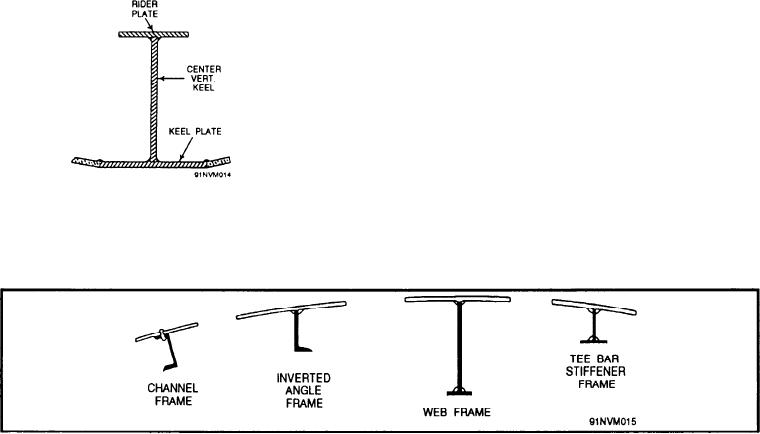
additional member is attached to this flange to serve as
HULL MEMBERS
the center strake.)
In the repair of ships, it is important that you have
The web of the I-beam is a solid plate that is called
an understanding of basic ship structure. Therefore, the
the vertical keel. The upper flange is called the rider
following section will discuss the structural parts of a
plate; this forms the center strake of the inner bottom
ship and the purpose of the parts.
plating. An inner vertical keel of two or more sections,
consisting of I-beams arranged one on top of the other,
The principal strength members of the ship's
is found on many large combatant ships.
structure are located at the top and bottom of the hull
where the greatest stresses occur. The top section
FRAMING
includes the main deck plating, the deck girders, and
the sheer strakes of the side plating. The bottom section
Frames used in ship construction may be of various
includes the keel, the outer bottom plating, the inner
shapes. Frames are strength members. They act as
bottom plating, and any continuous longitudinals in way
integral parts of the ship girder when the ship is
of the bottom. The side webs of the ship girder are
exposed to longitudinal or transverse stresses. Frames
composed of the side plating, aided to some extent by
stiffen the plating and keep it from bulging or buckling.
any long, continuous fore-and-aft bulkheads. Some of
They act as girders between bulkheads, decks, and
the strength members of a destroyer hull girder are
double bottoms, and transmit forces exerted by load
indicated in figure 2-6.
weights and water pressures. The frames also support
the inner and outer shell locally and protect against
KEEL
unusual forces, such as those caused by underwater
explosions. Frames are called upon to perform a variety
The keel is the most important structural member of
of functions, depending upon the location of the frames
a ship. It is considered to be the backbone of the ship.
in the ship. Figure 2-8 shows various types of frames
The keel is built up of plates and angles into an I-beam
used on board ship.
shape (fig. 2-7). The lower flange of this I-beam
structure is the flat keel plate, which forms the center
There are two important systems of framing in
strake of the bottom plating. (On large ships, an
current use:the transverse framing system and the
longitudinal framing system. The transverse system
provides for continuous transverse frames with the
widely spaced longitudinals intercostal between them.
Transverse frames are closely spaced and a small
number of longitudinals are used. The longitudinal
system of framing consists of closely spaced
longitudinals, which are continuous along the length of
the ship, with transverse frames intercostal between the
longitudinals.
Transverse frames are attached to the keel and
extend from the keel outward around the turn of the
bilge and up to the edge of the main deck. They are
closely spaced along the length of the ship, and they
define the form of the ship.
Figure 2-7.--Typical welded keel section.
Figure 2-8.--Types of frames used on board ship.
2-21

